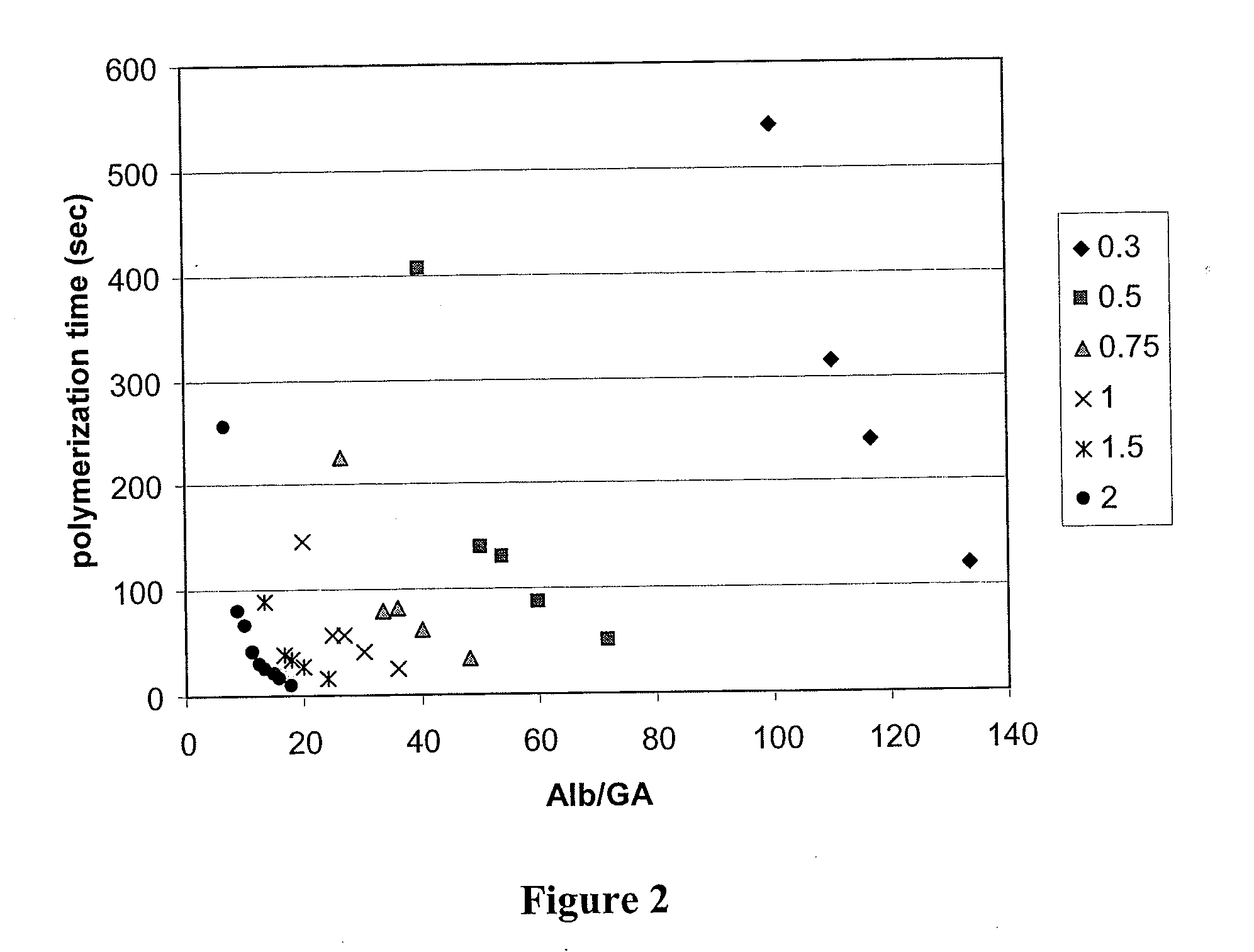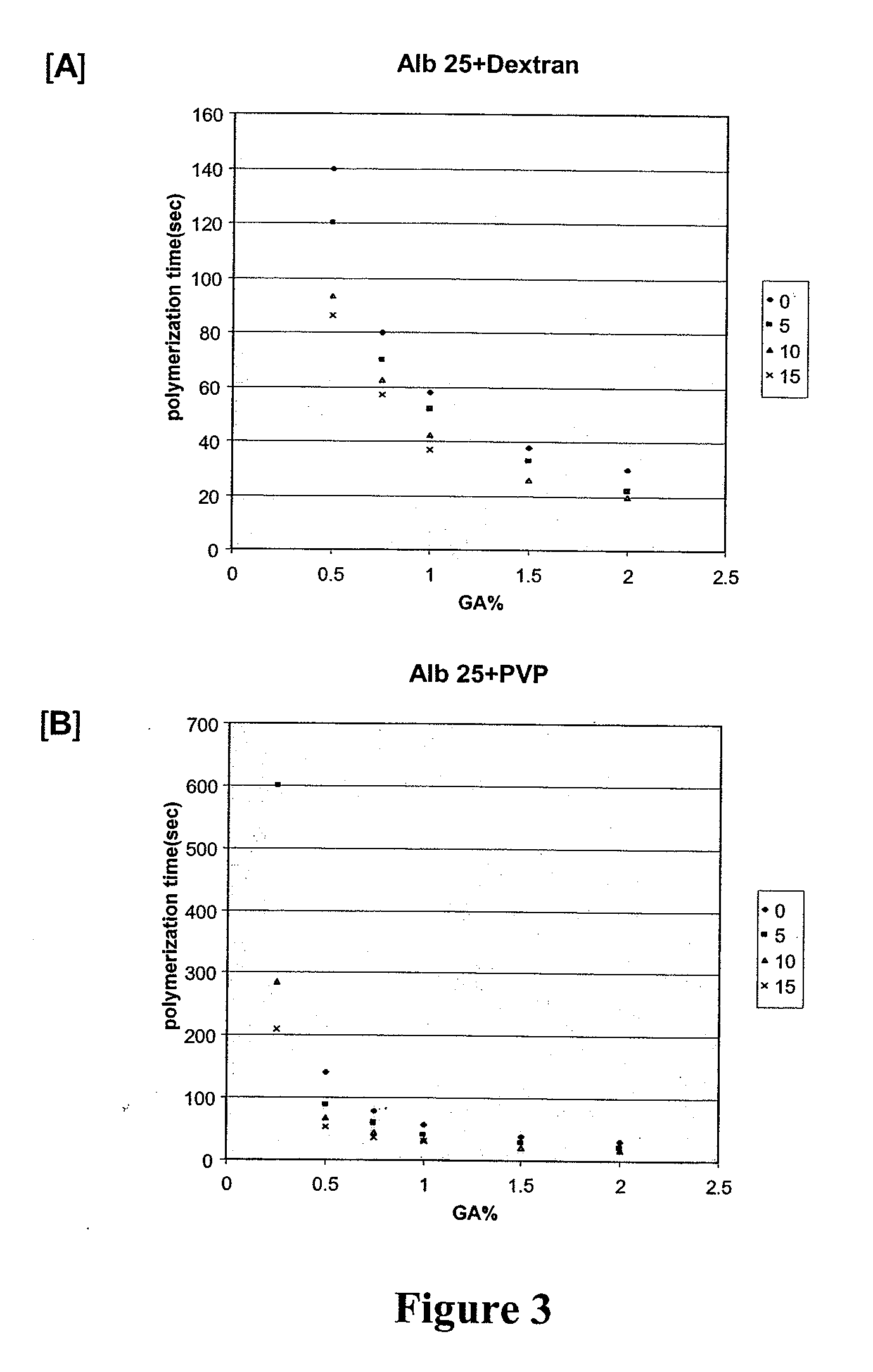Lung Volume Reduction Therapy Using Crosslinked Biopolymers
- Summary
- Abstract
- Description
- Claims
- Application Information
AI Technical Summary
Benefits of technology
Problems solved by technology
Method used
Image
Examples
example one
Bovine Serum Albumin & Glutaraldehyde In Vitro Experiments; Polymerization Time
[0383]The following experiments were done to determine the effects of albumin and glutaraldehyde (GA) concentrations on polymerization time. In addition, the following experiments were done to determine the effects of additives (such as polyvinylpyrrolidone and dextran) on polymerization time of albumin / glutaraldehyde mixtures.
[0384]The following reagents and equipment were used: bovine serum albumin (Sigma A7906); polyvinylpyrrolidone (Aldrich 856568); glutaraldehyde 25% w / v (Acros 11998-0010); dextran HMW (Sigma D4876); water; 2 mL microfuge tubes; syringes; needles; timer; and a vortex mixer. The following stock solutions were prepared: a 45% albumin stock in water; a 50% PVP stock in water; and a 50% dextran stock in water.
B. General Procedure
[0385]The general procedure used was that a glutaraldehyde mixture (0.1 mL) was added to an albumin mixture (0.9 mL), which may include polyvinylpyrrolidone or d...
example two
Human Serum Albumin & Glutaraldehyde In Vitro Experiments; Polymerization Times
[0394]The following experiments were done to determine the effect of substituting human serum albumin (HSA) for bovine serum albumin (BSA) on polymerization time of albumin / glutaraldehyde (GA) mixtures; and to determine if foams can be generated from such mixtures that can be injected through a small bore catheter.
[0395]The following reagents and equipment were used: 25% Human serum albumin (HSA; Baxter 1500233); polyvinylpyrrolidone (PVP; Aldrich 856568); glutaraldehyde 25% w / v (Acros 11998-0010); 2 mL microfuge tubes; syringes; needles; timer; vortex mixer; three-way stopcocks; and a 5F 130 cm single lumen catheter. The following stock solutions were prepared: 25% HSA with 5% PVP; and 25% HSA with 10% PVP.
[0396]In order to measure polymerization times, as described above, an albumin mixture (0.9 mL), which may include polyvinylpyrrolidone or dextran, was prepared in 2 mL microfuge tube. A glutaraldehyde...
example three
Albumin / GA In Vivo Experiments in Sheep
[0402]As disclosed in the previous examples, albumin / GA mixtures with desirable properties for BLVR were identified through a series of in vitro experiments. In this example, these formulations were used to perform BLVR in sheep to evaluate efficacy and toxicity of these formulations.
[0403]Anesthesia was induced with ketamine 2 mg / kg, midazolam 0.3 mg / kg, and propofol 70 mg IV and maintained with propofol continuous infusion. Animals were intubated fiberoptically with a 10 mm oral endotracheal tube and mechanically ventilated with RR 12, TV 500. A baseline CT scan was obtained at 25 cm H2O transpulmonary pressure, measured with an esophageal balloon.
[0404]The bronchoscope was wedged in a target segmental airway. The delivery catheter was passed through the working channel of the bronchoscope until its tip was visible 1-2 cm beyond the end of the bronchoscope.
[0405]The GA solution was added to the albumin solution and mixed with oxygen from a wa...
PUM
| Property | Measurement | Unit |
|---|---|---|
| Percent by mass | aaaaa | aaaaa |
| Percent by mass | aaaaa | aaaaa |
| Percent by mass | aaaaa | aaaaa |
Abstract
Description
Claims
Application Information
 Login to View More
Login to View More - R&D
- Intellectual Property
- Life Sciences
- Materials
- Tech Scout
- Unparalleled Data Quality
- Higher Quality Content
- 60% Fewer Hallucinations
Browse by: Latest US Patents, China's latest patents, Technical Efficacy Thesaurus, Application Domain, Technology Topic, Popular Technical Reports.
© 2025 PatSnap. All rights reserved.Legal|Privacy policy|Modern Slavery Act Transparency Statement|Sitemap|About US| Contact US: help@patsnap.com



